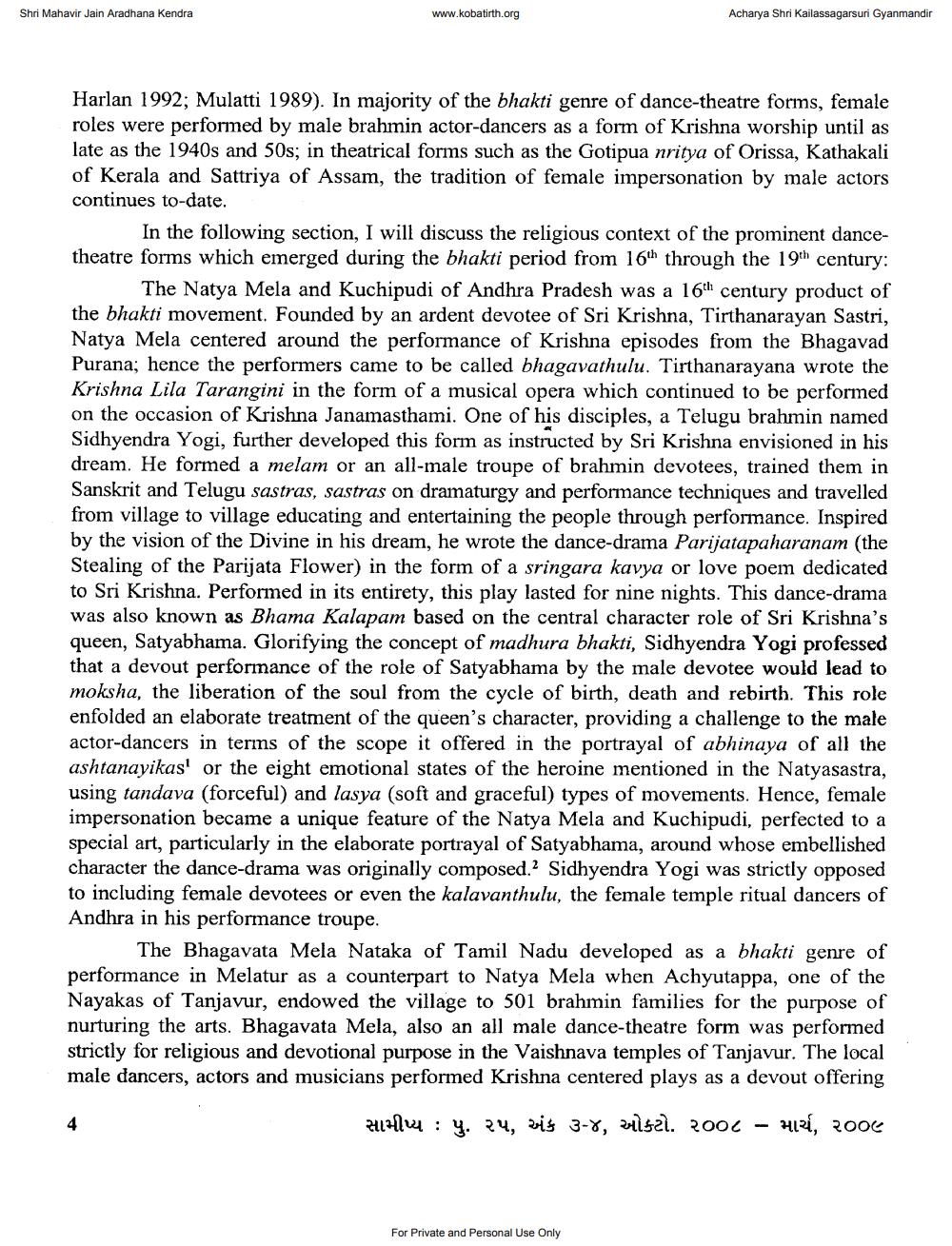Book Title: Samipya 2008 Vol 25 Ank 03 04 Author(s): R T Savalia Publisher: Bholabhai Jeshingbhai Adhyayan Sanshodhan Vidyabhavan View full book textPage 7
________________ Shri Mahavir Jain Aradhana Kendra www.kobatirth.org Acharya Shri Kailassagarsuri Gyanmandir Harlan 1992; Mulatti 1989). In majority of the bhakti genre of dance-theatre forms, female roles were performed by male brahmin actor-dancers as a form of Krishna worship until as late as the 1940s and 50s; in theatrical forms such as the Gotipua nritya of Orissa, Kathakali of Kerala and Sattriya of Assam, the tradition of female impersonation by male actors continues to-date. In the following section, I will discuss the religious context of the prominent dancetheatre forms which emerged during the bhakti period from 16th through the 19th century: The Natya Mela and Kuchipudi of Andhra Pradesh was a 16th century product of the bhakti movement. Founded by an ardent devotee of Sri Krishna, Tirthanarayan Sastri, Natya Mela centered around the performance of Krishna episodes from the Bhagavad Purana; hence the performers came to be called bhagavathulu. Tirthanarayana wrote the Krishna Lila Tarangini in the form of a musical opera which continued to be performed on the occasion of Krishna Janamasthami. One of his disciples, a Telugu brahmin named Sidhyendra Yogi, further developed this form as instructed by Sri Krishna envisioned in his dream. He formed a melam or an all-male troupe of brahmin devotees, trained them in Sanskrit and Telugu sastras, sastras on dramaturgy and performance techniques and travelled from village to village educating and entertaining the people through performance. Inspired by the vision of the Divine in his dream, he wrote the dance-drama Parijatapaharanam (the Stealing of the Parijata Flower) in the form of a sringara kavya or love poem dedicated to Sri Krishna. Performed in its entirety, this play lasted for nine nights. This dance-drama was also known as Bhama Kalapam based on the central character role of Sri Krishna's queen, Satyabhama. Glorifying the concept of madhura bhakti, Sidhyendra Yogi professed that a devout performance of the role of Satyabhama by the male devotee would lead to moksha, the liberation of the soul from the cycle of birth, death and rebirth. This role enfolded an elaborate treatment of the queen's character, providing a challenge to the male actor-dancers in terms of the scope it offered in the portrayal of abhinaya of all the ashtanayikas' or the eight emotional states of the heroine mentioned in the Natyasastra, using tandava (forceful) and lasya (soft and graceful) types of movements. Hence, female impersonation became a unique feature of the Natya Mela and Kuchipudi, perfected to a special art, particularly in the elaborate portrayal of Satyabhama, around whose embellished character the dance-drama was originally composed. Sidhyendra Yogi was strictly opposed to including female devotees or even the kalavanthulu, the female temple ritual dancers of Andhra in his performance troupe. The Bhagavata Mela Nataka of Tamil Nadu developed as a bhakti genre of performance in Melatur as a counterpart to Natya Mela when Achyutappa, one of the Nayakas of Tanjavur, endowed the village to 501 brahmin families for the purpose of nurturing the arts. Bhagavata Mela, also an all male dance-theatre form was performed strictly for religious and devotional purpose in the Vaishnava temples of Tanjavur. The local male dancers, actors and musicians performed Krishna centered plays as a devout offering zulu : y. 24, vis 3-8, sel. 2001 – Hizé, 2006 For Private and Personal Use OnlyPage Navigation
1 ... 5 6 7 8 9 10 11 12 13 14 15 16 17 18 19 20 21 22 23 24 25 26 27 28 29 30 31 32 33 34 35 36 37 38 39 40 41 42 43 44 45 46 47 48 49 50 51 52 53 54 55 56 57 58 59 60 61 62 63 64 65 66 67 68 69 70 71 72 ... 164
